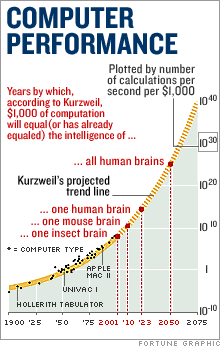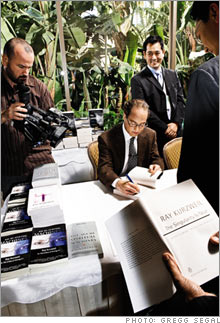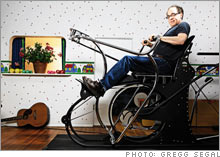The smartest futurist on EarthIf legendary inventor Ray Kurzweil is right, the future will be a lot brighter - and weirder - than you think.(Fortune Magazine) -- If you went around saying that in a couple of decades we'll have cell-sized, brain-enhancing robots circulating through our bloodstream, or that we'll be able to upload a person's consciousness into a computer, people would probably question your sanity. But if you say things like that and you're Ray Kurzweil, you get invited to dinner at Bill Gates' house - twice - so he can pick your brain for insights on the future of technology. The Microsoft (Charts, Fortune 500) chairman calls him a "visionary thinker and futurist."
Kurzweil is an inventor whose work in artificial intelligence has dazzled technological sophisticates for four decades. He invented the flatbed scanner, the first true electric piano, and large-vocabulary speech-recognition software; he's launched ten companies and sold five, and has written five books; he has a BS in computer science from MIT and 13 honorary doctorates (but no real one); he's been inducted into the Inventor's Hall of Fame and charges $25,000 every time he gives a speech - 40 times last year. And now, if anything, he's gaining momentum as a cultural force: He has not one but two movies in the works - one a documentary about his career and ideas and the other an adaptation of his recent bestseller, The Singularity Is Near, which he's writing and co-producing (he's talking about a distribution deal with the people who brought you The Day After Tomorrow). When Kurzweil isn't giving keynote addresses or reading obscure peer-review journals, he's raising money for his new hedge fund, FatKat (Financial Accelerating Transactions from Kurzweil Adaptive Technologies). He's already attracted a roster of blue-ribbon investors that includes venture capitalist Vinod Khosla, former Microsoft CFO Mike Brown, and former Flextronics (Charts)-CEO-turned-KKR-partner Michael Marks. Being a hedge fund manager may seem an odd pursuit for an expert in artificial intelligence, but to Kurzweil it's perfectly natural. The magic that has enabled all his innovations has been the science of pattern recognition - and what is the financial market, he postulates, but a series of patterns? Kurzweil, however, has something bigger on his mind than just making money -after half a lifetime studying trends in technological change, he believes he's found a pattern that allows him to see into the future with a high degree of accuracy. The secret is something he calls the Law of Accelerating Returns, and the basic idea is that the power of technology is expanding at an exponential rate. Mankind is on the cusp of a radically accelerating era of change unlike anything we have ever seen, he says, and almost more extreme than we can imagine. Everything will be subject to his Law of Accelerating Returns, Kurzweil says, because "everything is ultimately becoming information technology." As we are able to reverse-engineer and decode our own DNA, for instance, medical technology can be converted to bits and bytes and zoom along at the same fantastic rate. That will enable overlapping revolutions in genetics, nanotechnology, and robotics. Which is how you end up with nanobots living in your brain. And if you're a Baby Boomer with the right fitness plan (for Kurzweil that involves over 200 supplement pills a day plus intravenous treatments once a week), you may just live long enough to live forever. By the time a child born today graduates from college, Kurzweil believes, poverty, disease, and reliance on fossil fuels should be a thing of the past. Speaking of which, don't get him started on global-warming hype. "These slides that Gore puts up are ludicrous," says the man who once delivered a tech conference presentation as a singing computer avatar named Ramona. (That stunt was the inspiration for the 2002 Al Pacino movie Simone.) "They don't account for anything like the technological progress we're going to experience." Kurzweil's crusade, if you will, is to get across that most of us (even most of his fellow scientists) fail to see the world changing exponentially because we are "stuck in the intuitive linear view." To hammer home his point, Kurzweil packs his presentations with charts that show, for instance, supercomputer power doubling consistently over time. He explains that Moore's Law - the number of transistors on a chip will double every two years - is but one excellent example of the Law of Accelerating Returns. One of Kurzweil's favorite illustrations of exponential growth is the Human Genome Project. "It was scheduled to be a 15-year project," he says. "After seven years only 1% of it was done, and the critics said it would be impossible. But if you double from 1% every year over seven years, you get 100%. It was right on schedule." He believes humanity is near that 1% moment in technological growth. By 2027, he predicts, computers will surpass humans in intelligence; by 2045 or so, we will reach the Singularity, a moment when technology is advancing so rapidly that "strictly biological" humans will be unable to comprehend it. He has plenty more ideas that may seem Woody Allen - wacky in a Sleeper kind of way (virtual sex as good as or better than the real thing) and occasionally downright disturbing � la 2001: A Space Odyssey (computers will achieve consciousness in about 20 years). But a number of his predictions have had a funny way of coming true. Back in the 1980s he predicted that a computer would beat the world chess champion in 1998 (it happened in 1997) and that some kind of worldwide computer network would arise and facilitate communication and entertainment (still happening). His current vision goes way, way past the web, of course. But at least give the guy a hearing. "We are the species that goes beyond our potential," he says. "Merging with our technology is the next stage in our evolution." This story was originally published in the May 14, 2007 issue of Fortune. To read the full story, click here. |
Sponsors
| ||||||||||||||||



